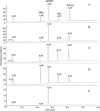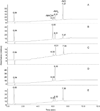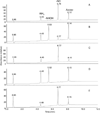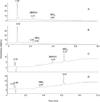Reduction of aromatic and heterocyclic aromatic N-hydroxylamines by human cytochrome P450 2S1
- PMID: 23682735
- PMCID: PMC3707514
- DOI: 10.1021/tx400139p
Reduction of aromatic and heterocyclic aromatic N-hydroxylamines by human cytochrome P450 2S1
Abstract
Many aromatic amines and heterocyclic aromatic amines (HAAs) are known carcinogens for animals, and there is also strong evidence of some in human cancer. The activation of these compounds, including some arylamine drugs, involves N-hydroxylation, usually by cytochrome P450 enzymes (P450) in Family 1 (1A2, 1A1, and 1B1). We previously demonstrated that the bioactivation product of the anticancer agent 2-(4-amino-3-methylphenyl)-5-fluorobenzothiazole (5F 203), an N-hydroxylamine, can be reduced by P450 2S1 to its amine precursor under anaerobic conditions and, to a lesser extent, under aerobic conditions [Wang, K., and Guengerich, F. P. (2012) Chem. Res. Toxicol. 25, 1740-1751]. In the study presented here, we tested the hypothesis that P450 2S1 is involved in the reductive biotransformation of known carcinogenic aromatic amines and HAAs. The N-hydroxylamines of 4-aminobiphenyl (4-ABP), 2-naphthylamine (2-NA), and 2-aminofluorene (2-AF) were synthesized and found to be reduced by P450 2S1 under both anaerobic and aerobic conditions. The formation of amines due to P450 2S1 reduction also occurred under aerobic conditions but was less apparent because the competitive disproportionation reactions (of the N-hydroxylamines) also yielded amines. Further, some nitroso and nitro derivatives of the arylamines could also be reduced by P450 2S1. None of the amines tested were oxidized by P450 2S1. These results suggest that P450 2S1 may be involved in the reductive detoxication of several of the activated products of carcinogenic aromatic amines and HAAs.
Figures










Similar articles
-
Bioactivation of fluorinated 2-aryl-benzothiazole antitumor molecules by human cytochrome P450s 1A1 and 2W1 and deactivation by cytochrome P450 2S1.Chem Res Toxicol. 2012 Aug 20;25(8):1740-51. doi: 10.1021/tx3001994. Epub 2012 Jul 10. Chem Res Toxicol. 2012. PMID: 22734839 Free PMC article.
-
Cytochrome P450 activation of arylamines and heterocyclic amines.Annu Rev Pharmacol Toxicol. 2005;45:27-49. doi: 10.1146/annurev.pharmtox.45.120403.100010. Annu Rev Pharmacol Toxicol. 2005. PMID: 15822170 Review.
-
Mechanisms of cytochrome P450 1A2-mediated formation of N-hydroxy arylamines and heterocyclic amines and their reaction with guanyl residues.Princess Takamatsu Symp. 1995;23:78-84. Princess Takamatsu Symp. 1995. PMID: 8844798 Review.
-
Metabolic activation of carcinogenic heterocyclic aromatic amines by human liver and colon.Carcinogenesis. 1991 Oct;12(10):1839-45. doi: 10.1093/carcin/12.10.1839. Carcinogenesis. 1991. PMID: 1934265
-
Metabolism of carcinogenic heterocyclic and aromatic amines by recombinant human cytochrome P450 enzymes.Carcinogenesis. 1997 Apr;18(4):851-4. doi: 10.1093/carcin/18.4.851. Carcinogenesis. 1997. PMID: 9111224
Cited by
-
Xenobiotica-metabolizing enzymes in the skin of rat, mouse, pig, guinea pig, man, and in human skin models.Arch Toxicol. 2018 Aug;92(8):2411-2456. doi: 10.1007/s00204-018-2232-x. Epub 2018 Jun 18. Arch Toxicol. 2018. PMID: 29916051 Free PMC article. Review.
-
Xenobiotic-metabolizing enzymes in the skin of rat, mouse, pig, guinea pig, man, and in human skin models.Arch Toxicol. 2014 Dec;88(12):2135-90. doi: 10.1007/s00204-014-1382-8. Epub 2014 Nov 5. Arch Toxicol. 2014. PMID: 25370008 Free PMC article. Review.
-
Nitroreduction: A Critical Metabolic Pathway for Drugs, Environmental Pollutants, and Explosives.Chem Res Toxicol. 2022 Oct 17;35(10):1747-1765. doi: 10.1021/acs.chemrestox.2c00175. Epub 2022 Aug 31. Chem Res Toxicol. 2022. PMID: 36044734 Free PMC article. Review.
-
Human cytochrome P450 oxidation of 5-hydroxythalidomide and pomalidomide, an amino analogue of thalidomide.Chem Res Toxicol. 2014 Jan 21;27(1):147-56. doi: 10.1021/tx4004215. Epub 2013 Dec 24. Chem Res Toxicol. 2014. PMID: 24350712 Free PMC article.
-
Erectile Dysfunction Drugs Changed the Protein Expressions and Activities of Drug-Metabolising Enzymes in the Liver of Male Rats.Oxid Med Cell Longev. 2016;2016:4970906. doi: 10.1155/2016/4970906. Epub 2016 Oct 9. Oxid Med Cell Longev. 2016. PMID: 27800121 Free PMC article.
References
-
- Guengerich FP. Common and uncommon cytochrome P450 reactions related to metabolism and chemical toxicity. Chem. Res. Toxicol. 2001;14:611–650. - PubMed
-
- Guengerich FP. Cytochrome P450 and chemical toxicology. Chem. Res. Toxicol. 2008;21:70–83. - PubMed
-
- Williams JA, Hyland R, Jones BC, Smith DA, Hurst S, Goosen TC, Peterkin V, Koup JR, Ball SE. Drug-drug interactions for UDP-glucuronosyltransferase substrates: a pharmacokinetic explanation for typically observed low exposure AUCi/AUC ratios. Drug Metab. Dispos. 2004;32:1201–1208. - PubMed
-
- Wienkers LC, Heath TG. Predicting in vivo drug interactions from in vitro drug discovery data. Nat. Rev. Drug. Discov. 2005;4:825–833. - PubMed
Publication types
MeSH terms
Substances
Grants and funding
LinkOut - more resources
Full Text Sources
Other Literature Sources

